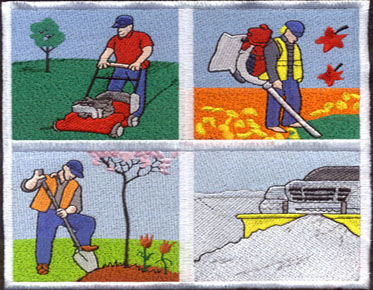Choosing Embroidery Thread
Selecting the right type of threads for any embroidery digitizing work is important because the color and texture of the design, and eventually the look of the final product depend on the material and type of thread used. There’s a wide variety of embroidery thread to choose from, so take your time to decide what type or combination should be best for the design you have in mind.
1. Rayon: This type of thread has a great sheen, and so the best looking embroidery designs are stitched with it. Rayon threads can range from combinations of two or more colors twisted together thereby forming a single strand, to one solid color strand. They are widely available, mostly in standard 40 wt. and 30 wt. Even though Rayon is the most popular type, it’s not very sturdy because of its thinness.
2. Polyester: Polyester thread is more durable than Rayon but it is not as attractive. However, this type of embroidery thread hardly shrinks or fades, and if combined with Rayon, the effect they provide is nearly indistinguishable. It is also cheaper than Rayon thread.
3. Cotton: Cotton thread allows for a wide range of tension adjustments because of its texture. It has a nice sheen, is quite sturdy (though finer threads above 50 wt. are not), and typically used for machine embroidery.
4. Silk: Silk embroidery thread hardly breaks and has its own unique, and probably the best sheen. Threads come in various sizes but their availability is low so they are mostly used for luxury fabrics.
5. Metallic Thread: This type of thread has a core wrapped with a metal foil which may be coated with silver alloy, and color is added to this foil with a polyester film which may also be applied as an undercoating. Metallic thread is one of the most durable available on the market.
6. Mylar Thread: Plies of film are combined into a layer, cut into slices to create Mylar threads. They are durable but may break under high-speed sewing. One unique color feature is holographic hue, which picks up and reflects light or color from other surrounding objects. This really enhances the color and design of the embroidery.
7. Special-effect: Like the name suggests, this type of thread can be used to create different embroidery design effects, such as crewel-like effect. Some of the special effect threads change colors under sunlight, or may glow in the dark.
1. Rayon: This type of thread has a great sheen, and so the best looking embroidery designs are stitched with it. Rayon threads can range from combinations of two or more colors twisted together thereby forming a single strand, to one solid color strand. They are widely available, mostly in standard 40 wt. and 30 wt. Even though Rayon is the most popular type, it’s not very sturdy because of its thinness.
2. Polyester: Polyester thread is more durable than Rayon but it is not as attractive. However, this type of embroidery thread hardly shrinks or fades, and if combined with Rayon, the effect they provide is nearly indistinguishable. It is also cheaper than Rayon thread.
3. Cotton: Cotton thread allows for a wide range of tension adjustments because of its texture. It has a nice sheen, is quite sturdy (though finer threads above 50 wt. are not), and typically used for machine embroidery.
4. Silk: Silk embroidery thread hardly breaks and has its own unique, and probably the best sheen. Threads come in various sizes but their availability is low so they are mostly used for luxury fabrics.
5. Metallic Thread: This type of thread has a core wrapped with a metal foil which may be coated with silver alloy, and color is added to this foil with a polyester film which may also be applied as an undercoating. Metallic thread is one of the most durable available on the market.
6. Mylar Thread: Plies of film are combined into a layer, cut into slices to create Mylar threads. They are durable but may break under high-speed sewing. One unique color feature is holographic hue, which picks up and reflects light or color from other surrounding objects. This really enhances the color and design of the embroidery.
7. Special-effect: Like the name suggests, this type of thread can be used to create different embroidery design effects, such as crewel-like effect. Some of the special effect threads change colors under sunlight, or may glow in the dark.
Share
Don't Have An Account?
Register Here



